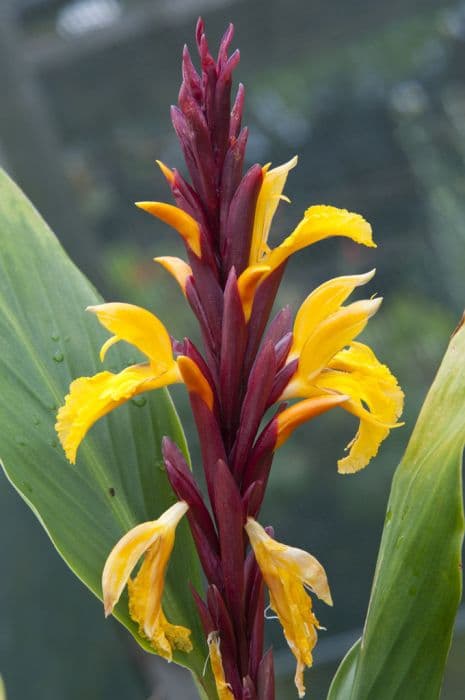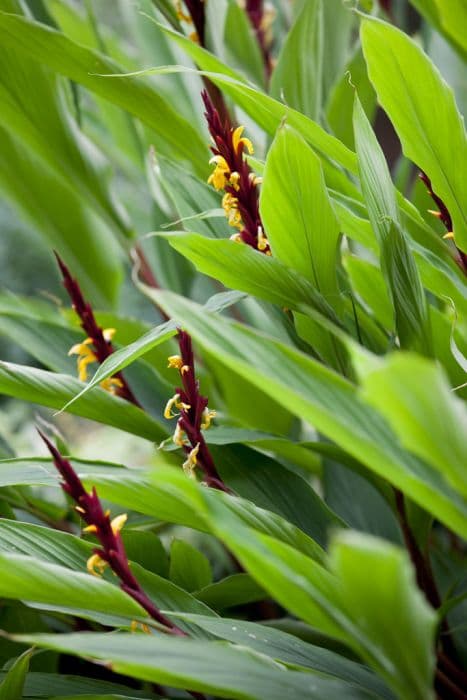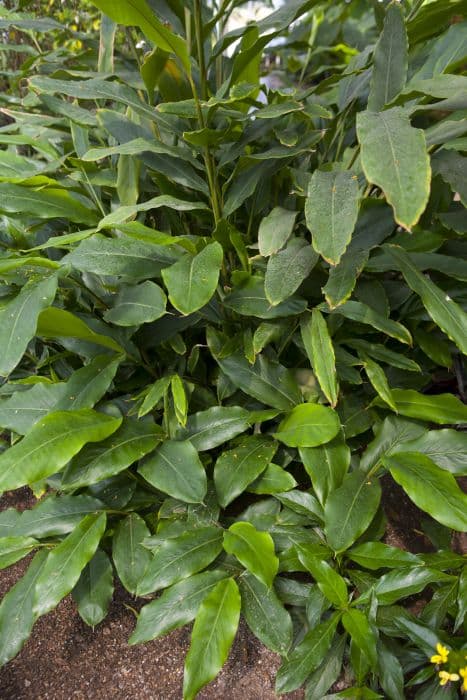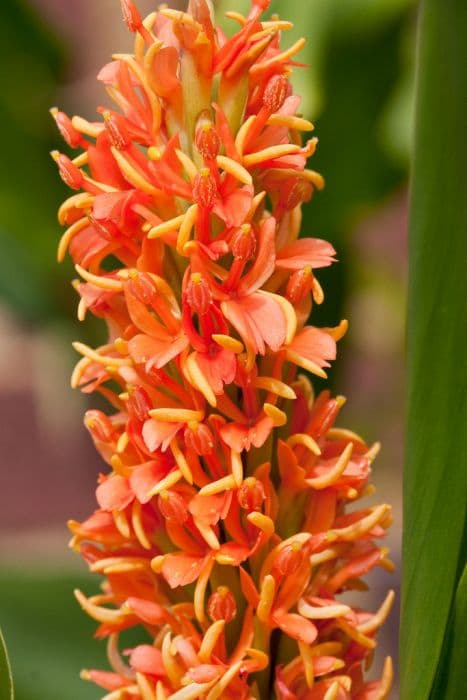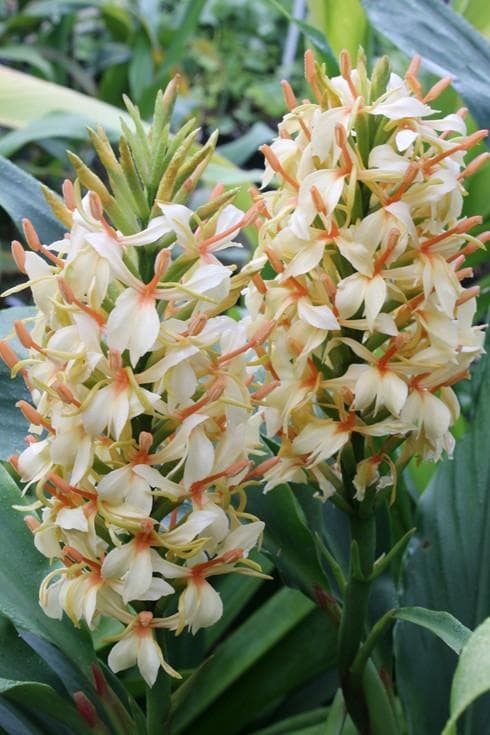Cautleya Spicata Roscoea cautleyoides 'Jeffrey Thomas'

ABOUT
Roscoea cautleyoides 'Jeffrey Thomas' is a striking perennial plant known for its exotic-looking flowers and lush foliage. The plant boasts a robust clump of narrow, lance-shaped leaves that are deep green in color, creating a vibrant, grass-like tuft. Come blooming time, the plant produces singular, attractive flowers situated atop slender, upright stems. These blossoms, rich in color, resemble orchids with their intricate, tubular shape and are admired for their delicate beauty. The flowers by themselves are a sight to behold, displaying a lovely shade of soft yet vibrant yellow. The blossoms feature a pair of petal-like structures, or labellum, that are often marked with a contrasting color, adding depth and complexity to their appearance. The way the flower is constructed gives it a poised and elegant look that can easily grab the attention of any onlooker. The visual appeal of Roscoea cautleyoides 'Jeffrey Thomas' is further enhanced when it is in full bloom, with multiple flowers creating a captivating display against the green backdrop of the foliage. The overall impression of the plant is one of grace and sophistication, making it a desirable addition to gardens where a touch of exotic charm is sought after. It tends to look attractive in woodland settings, rock gardens, or as part of border plantings where its showy flowers can be appreciated up close.
About this plant
 Names
NamesFamily
Zingiberaceae
Synonyms
Roscoea 'Jeffrey Thomas', Cautleya Spicata 'Jeffrey Thomas'
Common names
Roscoea cautleyoides 'Jeffrey Thomas'.
 Toxicity
ToxicityTo humans
The common name for Roscoea cautleyoides 'Jeffrey Thomas' is Cautleya. There is limited information on the toxicity of Cautleya to humans, and it is not commonly reported as a toxic plant. As a result, it is generally not considered poisonous, and there are no well-documented cases of poisoning or specific symptoms of toxicity associated with ingestion of this plant. However, as with any plant not typically used for food, it is prudent to avoid ingesting it and to seek medical advice if ingestion occurs and symptoms develop.
To pets
The common name for Roscoea cautleyoides 'Jeffrey Thomas' is Cautleya. Similar to the information available for humans, there is limited information regarding the toxicity of Cautleya to pets. It is not widely recognized as a toxic plant to animals such as dogs and cats. Therefore, there are no specific symptoms of poisoning reported for pets. However, as with all plants that are not explicitly known to be safe for pets, it is still advisable to prevent them from ingesting the plant, and to consult a veterinarian if ingestion occurs and any health concerns arise.
 Characteristics
CharacteristicsLife cycle
Perennials
Foliage type
Deciduous
Color of leaves
Green
Flower color
Yellow
Height
1-2 feet (30-60 cm)
Spread
1 foot (30 cm)
Plant type
Herb
Hardiness zones
6
Native area
Himalayas
Benefits
 General Benefits
General Benefits- Ornamental value: The plant produces attractive flowers that add aesthetic appeal to gardens and landscapes.
- Low maintenance: It does not require extensive care once established, making it suitable for gardeners of all skill levels.
- Drought tolerance: Once established, it is capable of withstanding periods of low water availability, making it suitable for xeriscaping.
- Cold hardiness: It is able to survive in cooler climates, which makes it versatile for different garden zones.
- Pollinator attraction: Its flowers can attract bees and butterflies, contributing to the health of the local ecosystem.
- Adaptability: It can thrive in a range of soil types as long as they are well-draining.
- Compact size: Its relatively small size makes it suitable for cultivation in smaller gardens or in containers.
- Seasonal interest: Provides a burst of color in the garden during its flowering season, usually in late spring to early summer.
- Non-invasive: Unlike some other plants, it does not aggressively spread, reducing the need for frequent management or control.
 Medical Properties
Medical PropertiesThis plant is not used for medical purposes.
 Air-purifying Qualities
Air-purifying QualitiesThis plant is not specifically known for air purifying qualities.
 Other Uses
Other Uses- Photography subject: Due to its striking appearance, Roscoea 'Jeffrey Thomas' is often used by photographers who specialize in botanical and nature photography.
- Culinary decoration: The blooms can be used to decorate food platters or as an elegant touch to gourmet dishes at high-end restaurants.
- Art inspiration: The unique form and color of the flowers serve as inspiration for botanical illustrators and artists.
- Educational tool: Botany educators may use this plant to teach students about the genetics of flower color and plant hybridization.
- Dye source: The pigments from the petals might be used in natural dyeing processes for textiles or artisanal crafts.
- Ecosystem support: By providing nectar, the plant contributes to the sustenance of pollinators like bees and butterflies in British gardens.
- Pot-pourri ingredient: The dried flowers can potentially be added to pot-pourri mixes for a natural, subtle scent.
- Floral arrangements: Though not traditional, these flowers can be used in creative floral arrangements for their unique look.
- Bioindicator: This plant may be used in ecological studies to indicate soil health or the impact of climate change in a given area.
- Paper making: The fibers from the plant could be explored as a material in handcrafted paper making processes.
Interesting Facts
 Feng Shui
Feng ShuiThe Roscoea is not used in Feng Shui practice.
 Zodiac Sign Compitability
Zodiac Sign CompitabilityThe Roscoea is not used in astrology practice.
 Plant Symbolism
Plant Symbolism- Rarity: As Roscoea cautleyoides 'Jeffrey Thomas' is not a well-known variety, it symbolizes uniqueness and the value of rare beauty in the world of plants.
- Adaptability: This plant has the ability to thrive in various conditions, representing the adaptability and resilience one can have in the face of different life situations.
- Charm and Attraction: With its beautiful flowers, the plant is often seen as a symbol of charming beauty and the power of attraction, drawing in not only people’s attention but also beneficial pollinators.
- Surprise: Since the plant is hardly known and can surprise a gardener upon discovering it, it embodies the joy of unexpected discoveries and serendipity in nature.
 Water
WaterThe Himalayan ginger prefers consistent moisture during growth, so water it deeply once a week, allowing the top inch of soil to dry out between watering sessions. Provide about 1 gallon of water per plant at each watering to ensure the soil is thoroughly moistened. This plant should not sit in waterlogged soil, so ensure proper drainage. Watering frequency may increase during hot, dry periods and decrease during cooler, rainy spells. Always check the soil moisture before watering to prevent overwatering.
 Light
LightHimalayan ginger thrives best in partial shade where it receives dappled sunlight. It should be protected from the harsh afternoon sun to avoid scorching its leaves. The ideal spot is under the canopy of larger plants or trees that provide filtered light, mimicking its natural woodland habitat.
 Temperature
TemperatureThe ideal temperature range for Himalayan ginger is between 60°F and 75°F. This plant can tolerate a minimum temperature of about 30°F for brief periods, but sustained cold or exposure to frost is detrimental. During the growing season, maintaining the temperature within the preferred range will promote healthy growth.
 Pruning
PruningPruning is not typically required for Himalayan ginger, but dead or damaged leaves can be trimmed away to maintain plant health and appearance. Pruning should be done after flowering, in the late summer or early fall, to avoid disrupting the growth cycle. Use clean, sharp scissors to make precise cuts.
 Cleaning
CleaningAs needed
 Soil
SoilThe best soil mix for the hardy ginger 'Jeffrey Thomas' should be rich, well-draining, and humus-rich with a pH range of 6.5–7.5 to match the plant's preference for a slightly acidic to neutral soil environment.
 Repotting
RepottingThe hardy ginger 'Jeffrey Thomas' should be repotted every 2 to 3 years to refresh the soil and accommodate its growth.
 Humidity & Misting
Humidity & MistingThe hardy ginger 'Jeffrey Thomas' thrives best in moderate humidity conditions, avoiding excessively dry or overly humid environments.
 Suitable locations
Suitable locationsIndoor
Keep hardy ginger 'Jeffrey Thomas' in bright, indirect light with good air circulation.
Outdoor
Place hardy ginger 'Jeffrey Thomas' in dappled shade with shelter from strong winds.
Hardiness zone
6-9 USDA
 Life cycle
Life cycleRoscoea cautleyoides 'Jeffrey Thomas', commonly known as "Ginger Lily", starts its life cycle as a rhizome, which remains dormant during winter. In the spring, shoots emerge from the rhizome, developing into stems with narrow lance-shaped leaves. The plant then flowers in summer, displaying its characteristic purple or yellow blooms which can attract pollinators such as bees. After pollination, the flowers may produce capsules containing seeds that mature by late summer or early autumn. The above-ground vegetation dies back to the ground in the fall, with the rhizome surviving underground during winter. The cycle repeats each spring, with the rhizome producing new growth annually.
 Propogation
PropogationPropogation time
Spring to Early Summer
The most popular method for propagating Roscoea cautleyoides 'Jeffrey Thomas', commonly known as Himalayan ginger, is division. The best time to propagate by division is in the spring, just as the new growth starts to emerge. Carefully dig up the plant, making sure to maintain a good clump of soil around the roots. Using a sharp knife or spade, divide the rhizome into sections, ensuring that each piece has at least one growth bud. Replant the sections at the same depth they were growing at previously, spacing them about 12 to 15 inches apart (30 to 38 cm). Water the newly planted divisions gently but thoroughly to settle the soil around the roots and help with the initial establishment.
